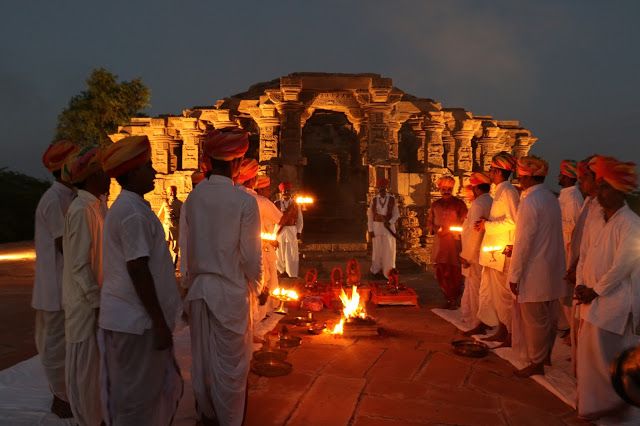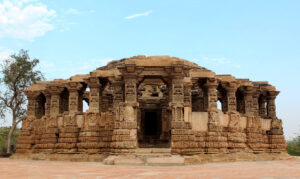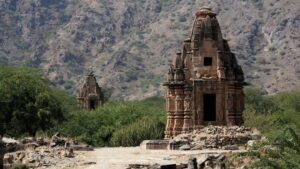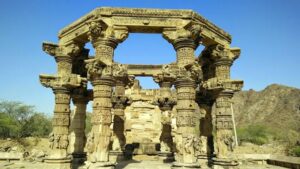
Introduction
Nestled amidst the stark and arid landscapes of Barmer in Rajasthan, the Kiradu Temples stand as silent sentinels of a bygone era. Dating back to the 11th century, these temples offer a mesmerizing glimpse into the rich history and cultural tapestry of the region. Carved from the golden sandstone that characterizes this desert land, the Kiradu Temples tell a tale of architectural splendor, intricate craftsmanship, and the ebb and flow of time.
Historical Roots
The Kiradu Temples, a group of five ancient temples dedicated to Lord Shiva, are believed to have been built in the 11th century by the Solanki dynasty. This dynasty, which held sway over parts of present-day Rajasthan and Gujarat, left an indelible mark on the region’s architectural and cultural heritage. The temples are said to have been commissioned by the Solanki ruler Bhima I, and their construction continued under subsequent rulers.

The temples are often compared to the Dilwara Temples of Mount Abu due to their architectural similarities, especially in the exquisite detailing and intricate carvings. This lends credence to the theory that the same artisans and craftsmen might have worked on both these sites, highlighting the interwoven history of the region.
Architectural Marvels
The Kiradu Temples exhibit a remarkable fusion of architectural styles, reflecting the cultural influences of the time. The main temple, dedicated to Lord Shiva, is a pinnacle of Maru-Gurjara architecture, a style that blends the indigenous Rajasthani style with influences from Gujarat. The temple’s spire, adorned with intricately carved figures and motifs, reaches for the heavens, a testament to the spiritual aspirations of the builders.
As one explores the complex, the other temples – dedicated to deities like Lord Vishnu, Goddess Parvati, and Lord Ganesha – reveal their own unique architectural nuances. The ornamentation, though weathered by centuries of desert winds and sandstorms, still manages to captivate visitors with its detailed sculptures and friezes.


Historical Significance
The historical significance of the Kiradu Temples lies not only in their architectural grandeur but also in the tales they whisper about the political and cultural dynamics of medieval Rajasthan. The Solanki rulers, who patronized the construction of these temples, sought to establish their authority and legitimacy through grand architectural projects. The temples served as not only places of worship but also as symbols of power and prestige.
Over the centuries, the region witnessed shifts in power, and the temples became a reflection of the changing political landscape. The intricate carvings on the temple walls depict scenes from Hindu mythology, daily life, and royal processions, offering a glimpse into the socio-cultural fabric of medieval Rajasthan.
Desert Erosion and Preservation Efforts
The harsh desert climate has taken its toll on the Kiradu Temples, with the relentless winds and sandstorms gradually eroding the delicate carvings and sculptures. The intricate details that once adorned the structures are now softened by the passage of time, and the facades bear the scars of centuries of exposure to the elements.
Recognizing the cultural and historical significance of the Kiradu Temples, various conservation efforts have been initiated to preserve these architectural marvels. The Archaeological Survey of India (ASI) has been actively involved in the restoration and maintenance of the site, employing traditional methods and modern technology to ensure the longevity of this cultural treasure.
Local Legends and Folklore
The Kiradu Temples are not only architectural wonders but also enshrouded in local legends and folklore. According to popular belief, the temples were cursed, and the region became desolate due to a tragic love story. The legend narrates the tale of a princess who fell in love with a commoner, leading to a series of events that brought misfortune to the kingdom. While historians dismiss such stories as myths, they add a layer of mystique to the Kiradu Temples, making them not just historical artifacts but also storytellers echoing the cultural imagination of the people.
Visitor Experience
For those who make the journey to Kiradu, the experience is both awe-inspiring and humbling. The barren landscape sets the stage for the temples to emerge like mirages on the horizon, their sandstone facades glowing golden in the sunlight. The stillness of the desert is broken only by the whispers of the wind and the occasional footsteps of visitors exploring the site.
Climbing the weathered steps of the main temple, visitors are greeted by a panorama of the surrounding desert, a vast and silent expanse that stretches as far as the eye can see. The intricate carvings come to life as the sun casts its warm glow on the sandstone, creating a play of light and shadow that adds to the ethereal beauty of the temples.
Conclusion
The Kiradu Temples of Barmer, though weathered by time and the harsh desert climate, stand as enduring testaments to the rich history and cultural heritage of Rajasthan. As the sun sets over the arid landscape, casting long shadows on the ancient stones, one can’t help but marvel at the resilience of these structures and the stories they hold. In the quiet solitude of the desert, the Kiradu Temples invite visitors to step back in time and contemplate the ebb and flow of civilizations against the backdrop of Rajasthan’s timeless beauty.















